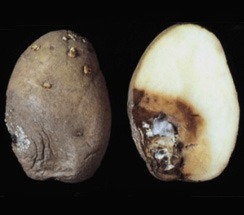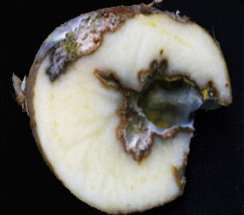| Dry rot: F. solani var. coeruleum |
Symptom:
- Dry dark spots appear on the skin which later becomes sunken and wrinkled with irregular concentric rings
- Spots shrinks and bursts out
- Internal tissue becomes brown and shrunken with cavities filled with numerous white tufts of mycelium
- Rotting progress into whole tuber which loses much of water and become dry hard, shriveled and light in weight
|
| |
 |
 |
 |
| |
Sunken and wrinkled potato |
Internal brown tissue |
Infected potato |
|
Identification of pathogen:
- Mycelium – branched, septate
- Hyphae break through the skin and form pustules on the surface
- Pustule – closely interwoven hyphae which give rise to branched conidiophores bearing conidia
Mode of spread and survival:
- Contaminated soil - chief source
- Mycelium, conidia and chlamydospores - present in the soil
- Conidia floating in the air or found on the floor and walls of stores infect injured tubers
Epidemiology:
- Temp -15 to 25°C
- RH - 50%
|
Management:
- Avoid injuries to tubers
- Potatoes should be dried thoroughly and then stored in a cool place
- To speed the healing process, hold tubers at 50° to 60°F with good ventilation and a RH of at least 95% for the first 2 to 3 weeks of storage
|
Source of Images:
https://www.agric.wa.gov.au/potatoes/fusarium-dry-rot-potatoes
http://pnwhandbooks.org/plantdisease/potato-solanum-tuberosum-fusarium-dry-rot
|


